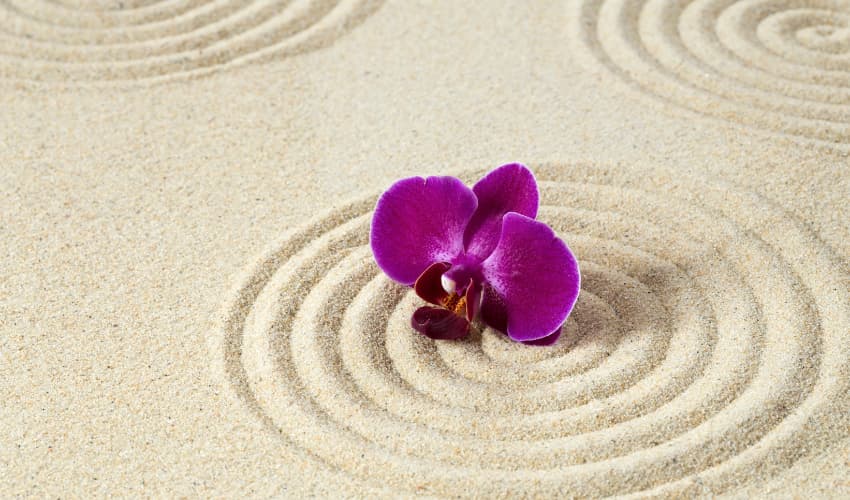Yoga Nidra, also known as “yogic sleep”, is a form of deep relaxation and meditation technique. It is a state of consciousness between waking and sleeping, in which the body is completely relaxed and the mind is heightened. Yoga Nidra is said to help deep-seated release tensions and repressed emotions and promote physical, emotional and mental balance.
The practice typically involves lying comfortably, with the eyes closed and the mind focused on a particular object or intention. The practitioner is guided through verbal instructions designed to relax the body and mind and bring awareness to different body parts. The idea is to reach a state of deep relaxation, where you can let go of thoughts and emotions, and the body can release tension.
Yoga Nidra is often used for stress reduction and can be helpful for people with insomnia, anxiety, and other stress-related conditions. It is a form of yoga that anyone can practice regardless of age, fitness level, or physical ability. Some people practice yoga Nidra as a standalone practice, while others include it as part of their regular yoga or meditation practice.
Yoga Nidra
Yoga Nidra was first described in the texts of tantra yoga, a branch of yoga that emphasises ritual and visualisation to achieve spiritual liberation. The origins of Yoga Nidra can be traced back to ancient India, where it was developed to induce deep relaxation and prepare the mind for meditation. The practice was traditionally taught by a guru (teacher) to advanced students who had already completed a certain level of mastery in other forms of yoga.
In the 20th century, Yoga Nidra was popularised by some Indian yoga teachers, including Swami Satyananda Saraswati, who developed a systematic approach to the practice that made it more accessible to a broader range of students. He wrote several books on the subject and founded the Bihar School of Yoga, which continues to teach and promote Yoga Nidra today.
The practice of Yoga Nidra has continued to evolve over the years, and today, it is widely recognised as a powerful tool for promoting physical, emotional, and mental well-being. It is taught in yoga studios, health centres, and other settings worldwide and is increasingly used as a therapeutic tool by healthcare professionals.
In short, Yoga Nidra is a practice rooted in ancient India and was part of the tantra yoga tradition. It was popularised in the 20th century by the teachings of Indian yoga teachers and has been widely adopted as a form of deep relaxation and meditation.
Yoga Nidra Basics
Here are the basic steps involved in a Yoga Nidra session:
- Find a comfortable, quiet place to lie down or sit.
- Close your eyes and take a few deep breaths, focusing on the sensation of the breath moving in and out of your body.
- Begin to systematically relax each part of your body, starting with your toes and working your way up to the crown of your head.
- Once your body is completely relaxed, focus on a specific word or phrase, such as “peace” or “calm,” and repeat it silently to yourself.
- Next, imagine a peaceful scene or place, such as a beach or a forest, and focus on the details of this scene.
- focus on your breath and the peaceful scene or word/phrase, allowing your mind to become calm and still.
- After some time, you can come back to your normal awareness, take a deep breath and open your eyes.
Yoga Nidra Tips
Tips for practising yoga nidra:
- Set a specific time and place for your practice: It’s helpful to set aside a specific time each day for your Yoga Nidra practice and to find a quiet and comfortable place where you can relax and focus.
- Use props: A bolster or pillow under the knees, a blanket over the body, and an eye pillow can help you to relax and feel comfortable.
- Have a guide: It can be helpful to use a recorded Yoga Nidra session or follow along with a live teacher. A guide can help you stay focused and on track and provide verbal cues for relaxing different body parts.
- Keep a journal: Recording your experiences after the session can be a powerful tool for reflection and self-awareness. It can also help you to track your progress and identify patterns in your thoughts and emotions.
- Be patient: Like any meditation practice, Yoga Nidra takes time and patience to master. Try not to get discouraged if you struggle to relax or focus. Regular practice makes it easier to quiet the mind and enter a state of deep relaxation.
- Remember the purpose is to relax: Yoga Nidra is a practice of relaxation, not sleep. You don’t need to fall asleep to get the benefits of the practice.
- Schedule it at the end of the day: Practicing Yoga Nidra before going to bed can help you to fall asleep more easily and also give you a more peaceful night’s sleep.
Yoga Nidra Benefits
Yoga Nidra can provide many physical, mental, and emotional benefits. Here are some of the most common benefits of Yoga Nidra:
- Stress relief: Yoga Nidra can help to reduce stress and anxiety by inducing a state of deep relaxation and reducing the activity of the sympathetic nervous system.
- Improved sleep: Yoga Nidra can help to improve sleep by reducing insomnia and promoting more restful sleep.
- Increased self-awareness: Yoga Nidra can help to increase self-awareness by promoting a deeper understanding of the mind-body connection and helping individuals access a deeper state of consciousness.
- Improved focus and concentration: Yoga Nidra can help to improve focus and concentration by reducing distractions and allowing individuals to focus on the present moment.
- Relief of chronic pain: Yoga Nidra can help to relieve chronic pain by reducing tension in the body and promoting a state of deep relaxation.
- Improved emotional well-being: Yoga Nidra can help to improve emotional well-being by promoting a sense of inner peace and helping individuals to work through unresolved emotional issues.
- Increased creativity and intuition: Yoga Nidra can help to increase creativity and intuition by accessing the subconscious mind and promoting a greater sense of self-awareness.
Yoga Nidra may vary from person to person, and a beginner should be under a qualified teacher’s guidance.
Tantra to Yoga Nidra
Tantra Yoga is closely associated with the practices of yoga nidra and other forms of deep relaxation and meditation.
Some of the texts that are considered to be the primary references of tantra yoga and related to yoga nidra are:
- The Hatha Yoga Pradipika: This text is considered one of the essential texts on the practice of Hatha yoga, and it describes various methods, including asanas, pranayama, mudras, bandhas, and shatkarmas, including yoga nidra.
- The Yoga Sutras of Patanjali: This text, written by the ancient Indian philosopher Patanjali, describes the eight limbs of yoga, including asanas, pranayama, and dhyana (meditation), and is considered a fundamental text for the practice of yoga.
- The Upanishads: These ancient texts are considered part of the Vedic literature and provide an understanding of the nature of the self, the ultimate reality and the path to liberation.
- The Tantra texts: Considered the primary reference of tantra yoga. They include the Kaulajnana-nirnaya, the Kularnava-tantra, the Jnana-bhairava, the Jnana-bhairava-tantra, the Rudrayamala-tantra, the Shatchakranirupana, the Shatchakranirupana-tantra, and the Vijnana-bhairava. They contain techniques and rituals related to yoga nidra, pranayama, mudras, and bandhas.
Hatha Yoga Pradipika
The Hatha Yoga Pradipika is one of the most important texts on the practice of Hatha yoga, and it was written in the 15th century by the Indian yogi Svatmarama. The text is divided into four chapters and covers various practices, including asanas, pranayama, mudras, bandhas and shatkarmas.
The Hatha Yoga Pradipika does not explicitly mention the term “yoga nidra”; however, it contains information related to yoga nidra practice. For example, it describes the importance of relaxation, concentration, and visualisation in Hatha yoga.
Chapter 1 of the Hatha Yoga Pradipika describes the importance of asanas and their role in preparing the body for pranayama and meditation. It represents 15 asanas, considered essential for the practice of Hatha yoga.
Chapter 2 of the text describes the practice of pranayama, including the proper techniques for inhaling, exhaling, and retaining the breath, as well as the benefits of pranayama, such as the purification of the nadis (energy channels) and the awakening of kundalini energy.
Chapter 3 describes the practice of mudras and bandhas, which are techniques used to control and direct the flow of prana (life force) in the body.
Chapter 4 describes the ultimate goal of Hatha yoga, which is the attainment of samadhi (a state of deep meditation and spiritual absorption). It also describes the dangers of attempting to achieve it prematurely.
Yoga Sutras of Patanjali
The Yoga Sutras of Patanjali is an ancient text written by the Indian philosopher Patanjali in the 2nd century BCE. It is considered a fundamental text for the practice of yoga, and it is divided into four chapters, known as “padas,” that cover the following topics:
Samadhi Pada: This chapter describes the nature of consciousness and the ultimate goal of yoga: the attainment of samadhi, a state of deep meditation and spiritual absorption.
Sadhana Pada: This chapter describes the practices and disciplines that are necessary for attaining samadhi, including the eight limbs of yoga, which are yama (ethical restraints), niyama (observances), asana (posture), pranayama (breathing), pratyahara (withdrawal of the senses), dharana (concentration), dhyana (meditation) and samadhi (absorption).
Vibhuti Pada: This chapter describes the supernatural powers and abilities that yoga can achieve.
Kaivalya Pada: This chapter describes the ultimate goal of yoga, which is liberation (kaivalya) from the cycle of birth and death.
Upanishads
The Upanishads are ancient texts considered part of Vedic literature and provide an understanding of the nature of the self, the ultimate reality, and the path to liberation. They are the foundation of the spiritual and philosophical teachings of Hinduism, Buddhism and Jainism. Upanishads are considered one of the most important texts of Indian philosophy, and they contain many teachings related to yoga and meditation.
It contains information related to the practice of yoga nidra, where it describes the importance of self-knowledge, the nature of consciousness and the ultimate goal of yoga, which is the attainment of liberation. The Upanishads encourage the practice of self-inquiry and self-reflection to understand one’s true nature.
Some Upanishads, such as the Mandukya Upanishad, describe the states of consciousness, including deep sleep, which is considered a form of yoga nidra. They also teach the nature of the self, the ultimate reality and the path to liberation.
The Upanishads provide a rich philosophical and spiritual foundation for practising yoga and meditation and contain teachings related to yoga nidra.
Swami Satyananda Saraswati Teachings of Yoga Nidra
Swami Satyananda Saraswati was a Hindu spiritual teacher and founder of India’s Bihar School of Yoga. He is known for his teachings on Yoga Nidra and for emphasising the connection between physical and mental well-being.
According to Swami Satyananda, Yoga Nidra is a powerful technique for inducing complete physical, mental, and emotional relaxation. He believed that by practising Yoga Nidra, individuals could access a deeper consciousness and achieve greater self-awareness.
Swami Satyananda’s teachings of Yoga Nidra focus on the use of various techniques, such as pratyahara (withdrawal of the senses), dharana (concentration), and dhyana (meditation), to achieve a state of deep relaxation. He also emphasised the importance of using a guide, such as a recorded session or a teacher, to help practitioners stay focused and on track during the practice.
He also believed that Yoga Nidra could be used to access the subconscious mind, work through unresolved emotional issues, and overcome various physical and psychological problems, such as insomnia, anxiety, and depression.
Finally, he considered that Yoga Nidra is a practice anyone can use regardless of their physical condition or spiritual background. It can be integrated into daily life to achieve outstanding balance and inner peace.
Pratyahara
Pratyahara is the withdrawal of the senses from external objects and turning the mind inward. It is the fifth limb of Ashtanga Yoga.
In the context of Yoga Nidra, pratyahara is the process of disengaging the senses from external stimuli and allowing the mind to focus inwardly. This is usually done by closing the eyes and concentrating on the breath or a specific word or phrase.
During a Yoga Nidra session, practitioners are typically instructed to disengage the senses by closing their eyes, disconnecting from external sounds, and reducing distractions. This helps to create an environment that is conducive to relaxation and meditation.
Practising pratyahara in Yoga Nidra helps quiet the mind and prepare the practitioner for the deeper stages of meditation. It allows the individual to focus on the inner experience and go beyond the distractions of the external world.
Pratyahara is also beneficial for managing stress and anxiety as it helps to disconnect from the external world’s constant stimulation and focus on the inner self.
Dharana
Dharana is the process of concentration and focus of the mind. It is the sixth limb of Ashtanga Yoga.
In the context of Yoga Nidra, dharana focuses the mind on a specific object, thought, or sensation. This can be done by focusing on the breath, a particular word, phrase, or image.
During a Yoga Nidra session, practitioners are typically instructed to focus on a specific word or phrase, such as “peace” or “calm,” or to imagine a peaceful scene, such as a beach or a forest. This helps to create a focal point for the mind and to reduce distractions.
The practice of dharana in Yoga Nidra helps to quiet the mind and prepare the practitioner for the deeper stages of meditation. It allows the individual to focus on one thing and go beyond the external world’s distractions.
Dharana is also beneficial for managing stress and anxiety as it helps to focus on the present moment, disconnect from the constant stimulation of the external world, and focus on the inner self.
Dharana is not the same as concentration, which is the ability to direct the mind to a particular object, thought or sensation and hold it there. Dharana is the first step in that direction; it’s a process of directing the mind to an object, thought, or sensation; the next step is Dhyana, which is the ability to hold the attention on the thing, thought or feeling without interruptions.
Dhyana
Dhyana is the process of deep meditation or meditative absorption, the seventh limb of Ashtanga Yoga.
In the context of Yoga Nidra, Dhyana is the stage where the mind is wholly absorbed in the object of focus, thought or sensation. It is the stage where the individual can focus on the thing, thought or feeling without interruptions.
During a Yoga Nidra session, practitioners are typically instructed to focus on their breath or a specific word or phrase and to hold their focus on that word or phrase without getting side-tracked by other thoughts. The goal is to reach a state of deep contemplation or absorption where the mind is entirely still and peaceful.
The practice of Dhyana in Yoga Nidra helps to quiet the mind and achieve a state of deep relaxation; it allows the individual to achieve a greater sense of self-awareness and inner peace.
Dhyana is also beneficial for managing stress and anxiety as it helps to disconnect from the external world’s constant stimulation and focus on the inner self; it is a powerful tool for reflection and self-awareness.
Dhyana is not the same as concentration or focus; Dharana is a deeper stage of meditation, where the mind is wholly absorbed in the object, thought or sensation, and the individual can focus on the thing, thought, or feeling without interruptions.
Yoga Nidra FAQs
Q: How often should I practice Yoga Nidra?
A: The frequency of practice will depend on your personal goals and schedule. It’s best to start practising once a week and increase the frequency as you feel comfortable. Some people find practising Yoga Nidra once daily enough, while others may benefit from practising several times a week.
Q: How long should a Yoga Nidra session last?
A: A typical Yoga Nidra session can last anywhere from 20 minutes to an hour. It’s best to start with shorter sessions and gradually increase the duration as you become more experienced.
Q: Can I practice Yoga Nidra while seated?
A: Yoga Nidra is traditionally practised while lying down but can also be done while seated. The important thing is to find a comfortable position where you can relax and focus on your breath.
Q: Can Yoga Nidra be used for healing?
A: Yoga Nidra can be used as a tool for healing by promoting relaxation and reducing stress, which can improve overall health. However, it’s essential to consult with a healthcare professional if you are experiencing a medical condition or have any concerns about your health.
Q: Can I practice Yoga Nidra while pregnant?
A: Yoga Nidra is generally considered safe for pregnant women, but it’s best to consult your healthcare provider before starting any new exercise or meditation practice during pregnancy.
Q: Can Yoga Nidra help with insomnia?
A: Yoga Nidra can help with insomnia by promoting relaxation and reducing stress, which can improve sleep. It can also help individuals better understand the mind-body connection, leading to better sleep habits.
Ayurah Spa & Wellness Centre
Ayurah Spa & Wellness Centre, offering a mind-balanced, body-rejuvenated journey of well-being. Ayurah Spa is a sanctuary that takes a results-oriented approach to wellness with rejuvenating spa treatments and therapies.
Wellness is a journey, an evolving process of the current condition of the mind, body and spirit. Ayurah Spa looks forward to supporting you in your quest for optimal relaxation, health and wellness.
Complimentary hatha yoga sessions are available Mon to Sun for Aleenta Phuket Resort & Spa guests.
Related Articles
- Hatha Yoga: An Introduction
- Ashram Yoga: A Journey of Self-Discovery
- Deeper Levels of Relaxation with Yoga Nidra
- Yoga Retreats, Stretch Your Body and Mind
- Vipassana Meditation: A Journey to Inner Peace
AYURAH SPA & WELLNESS CENTRE
33 Moo 5, Khok Kloi,
Takua Thung, Phang Nga
82140 Thailand
T: +66 (0) 76 580 339












